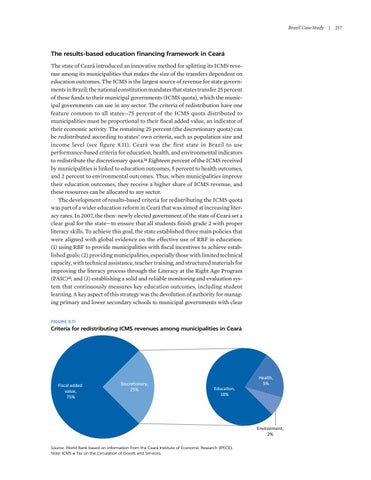Brazil Case Study | 217
The results-based education financing framework in Ceará The state of Ceará introduced an innovative method for splitting its ICMS revenue among its municipalities that makes the size of the transfers dependent on education outcomes. The ICMS is the largest source of revenue for state governments in Brazil; the national constitution mandates that states transfer 25 percent of these funds to their municipal governments (ICMS quota), which the municipal governments can use in any sector. The criteria of redistribution have one feature common to all states—75 percent of the ICMS quota distributed to municipalities must be proportional to their fiscal added value, an indicator of their economic activity. The remaining 25 percent (the discretionary quota) can be redistributed according to states’ own criteria, such as population size and income level (see figure 8.11). Ceará was the first state in Brazil to use performance-based criteria for education, health, and environmental indicators to redistribute the discretionary quota.14 Eighteen percent of the ICMS received by municipalities is linked to education outcomes, 5 percent to health outcomes, and 2 percent to environmental outcomes. Thus, when municipalities improve their education outcomes, they receive a higher share of ICMS revenue, and these resources can be allocated to any sector. The development of results-based criteria for redistributing the ICMS quota was part of a wider education reform in Ceará that was aimed at increasing literacy rates. In 2007, the then–newly elected government of the state of Ceará set a clear goal for the state—to ensure that all students finish grade 2 with proper literacy skills. To achieve this goal, the state established three main policies that were aligned with global evidence on the effective use of RBF in education: (1) using RBF to provide municipalities with fiscal incentives to achieve established goals; (2) providing municipalities, especially those with limited technical capacity, with technical assistance, teacher training, and structured materials for improving the literacy process through the Literacy at the Right Age Program (PAIC)15; and (3) establishing a solid and reliable monitoring and evaluation system that continuously measures key education outcomes, including student learning. A key aspect of this strategy was the devolution of authority for managing primary and lower secondary schools to municipal governments with clear FIGURE 8.11
Criteria for redistributing ICMS revenues among municipalities in Ceará
Fiscal added value, 75%
Discre onary, 25%
Educa on, 18%
Health, 5%
Environment, 2% Source: World Bank based on information from the Ceará Institute of Economic Research (IPECE). Note: ICMS = Tax on the Circulation of Goods and Services.






